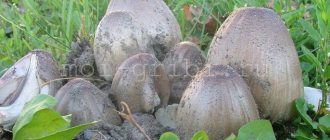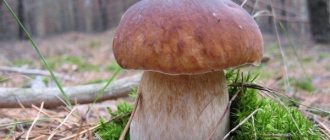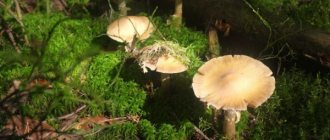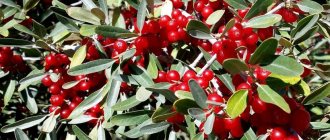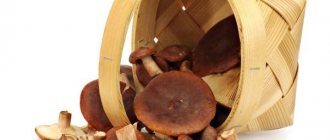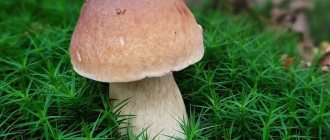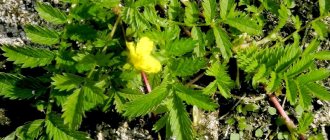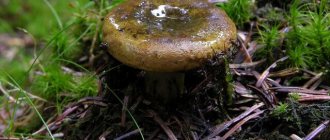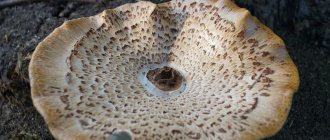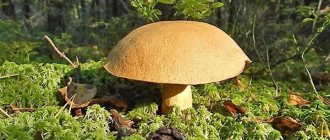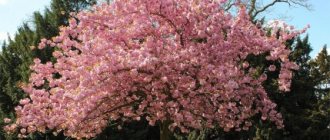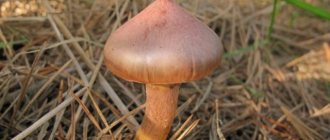Medicinal birch mushroom Chaga
The asexual form of the tinder fungus is called Chaga. The mushroom is also called black birch mushroom, as it grows on the trunks of birch trees. The fruit does not have clearly defined parts and is gray in color with a brown tint. This species is considered a parasite, since it enters the cracks of the trunk in the form of a spore and subsequently parasitizes it.
The inside of the fruit is brown with a reddish tint. The weight of one fruit part can reach 3 kg. It is collected at any time of the year only from healthy living trees. After this, the fruit is dried, cut into pieces and placed in jars.
The mushroom is not used in cooking, but is widely used in folk medicine. Thus, it is used to treat cancer, reduce blood cholesterol levels, normalize the gastrointestinal tract, restore the functioning of the central nervous system, improve immunity and treat inflammatory processes of the skin.
Such a wide spectrum of action is associated with the presence of a large number of useful substances, minerals and vitamins in the composition. To use Chaga, decoctions and tinctures are prepared from it by boiling the fruit.
Important!
Despite the usefulness of Chaga, it is not recommended for use by children under 12 years of age, pregnant women, people taking penicillin-based antibiotics, and patients with dysentery.
You may be interested in:
How to recognize a mushroom with a cap and a white stalk: names and types (32 photos) Mushrooms are a wonderful culinary product, successfully used for preparing various dishes. The most…Read more…
Household use
- From the white porous bottom surface, you can prepare a plaster that will have antifungal, antiseptic and self-adhesive properties.
- The mushroom was used by barbers for the final sharpening of straight razor blades.
- The mushroom was also used in the past as a very fine sandpaper for polishing metals, and was used to make ink and mounting bases for insect collections.
- It was used as tinder for starting fire, including for transporting it when moving from camp to camp.
- Can be used to repel mosquitoes, you need to cut them into slices, dry them and then simply set them on fire, mosquitoes are afraid of smoke and do not fly up.
A plate of dry tinder fungus must be fixed and set on fire; mosquitoes are afraid of smoke and do not fly up.
Edible mushrooms growing on a birch tree
In addition to Chaga, there are many birch mushrooms that also grow directly on the trunk. Oyster mushrooms and honey mushrooms are widely known and are often used in cooking to prepare various dishes. Among the oyster mushrooms there are no inedible or poisonous species, but the photo and description of the honey mushroom, for example, must be studied carefully in order to be able to distinguish it from the false one.
Oyster mushroom
Oyster mushrooms get their name because the fruiting bodies hang from the trunks of birch trees. They are not only tasty, but also healthy, which is why housewives often use them to prepare various dishes. There are many varieties of oyster mushrooms, and the most popular are ordinary, carob-shaped, pulmonary and orange.
Oyster mushroom or oyster mushroom is a large mushroom, the diameter of the cap reaches 30 cm. It is shell-shaped in shape, with edges directed inward and a smooth surface. Later it becomes flat.
The color is variable, it can be dark gray with a brown tint, ashen with a slight purple tint. The leg is short, curved, light. The pulp of the fruit part is light and soft, and becomes tougher with age. You can see the common oyster mushroom from early autumn to early winter.
You may be interested in:
How to distinguish real saffron milk caps from false mushrooms (28 photos)? Saffron milk caps are a popular forest delicacy in our country with an exquisite taste. Their taste qualities are not inferior to...Read more...
Oyster mushroom
The corniculate oyster mushroom differs from the previous one in that it has a smaller and funnel-shaped cap. The color is almost always light, with a grayish tint. The pulp is white and fleshy, odorless and tasteless.
Horn-shaped oyster mushroom
Pulmonary oyster mushroom has a thin tongue-shaped cap, with cracked edges, beige in color, the diameter of which reaches 8-9 cm. The lamellar part is descending. The pulp is always thin and elastic. The leg is almost invisible; it has slight pubescence.
A distinctive feature of the orange oyster mushroom is the bright orange color of its fruit part. The cap grows to the tree sideways, so most often it has an irregular shape with wavy edges. The surface of the cap is pubescent.
This variety has no stem completely, and the plates are large, wide, and orange. The taste and smell are weak putrid. The mushroom is considered inedible due to the fact that it is quite hard and has a specific taste and smell. Despite this, young fruits are still eaten.
You may be interested in:
What is the name of a mushroom with a red cap and its description (24 photos) Very often, mushroom pickers encounter many different mushrooms with a red cap in the forest. They usually look very...Read more...
Edible honey mushrooms
No less common are honey mushrooms. They are often used in cooking and are valued for their taste. They are divided into summer, autumn and winter depending on the peak of yield.
Summer honey mushrooms have a thin cap with edges turned inward, which straighten with age. The hat is colored yellow with a brown tint. The diameter of the cap does not exceed 8 cm, and centric water circles may appear over its entire surface. Over time, the circles disappear.
On the inside of the cap there is a plate system that becomes darker over time. The leg is tall, brown and thin, has a ring and scales located below it. You can see summer honey mushrooms from July until the first snow.
Autumn honey mushrooms are distinguished by a flat cap with wavy edges, colored green-brown. The pulp of autumn honey mushrooms is soft, dense and white. The leg is tall, widened at the base, and covered with scales. You can see autumn honey mushrooms from the end of August to the end of autumn.
Winter mushrooms cannot be confused with anything, since the surface of their cap is glossy, light brown in color with a reddish tint. It is convex in shape. The pulp is thin and tough, mostly white. The leg is cylindrical, 8 cm in height, light brown in color. You can find this variety from the onset of cold weather until the beginning of spring.
Features of wood mushrooms
Many types of tree mushrooms act as forest health workers, since they are bred on weakened trees and help the natural selection of quality species. Representatives of such “orderlies” known to us, for example, are honey mushrooms, which grow beautifully on stumps in a large family and attract mushroom hunters with a spicy aroma. In addition, they are tasty, crispy, and are especially loved by gourmets when marinated.
But there are mushrooms that are completely different from traditional ones; they have neither a cap nor a stem. They are qualified and recognized by their shape and appearance, which reminds us of things familiar in everyday life. It never occurred to anyone to collect them and taste them, so the taste qualities of these eccentric specimens are not known for certain.
Such xylotrophs can be distinguished by a description of their appearance:
- Meat pieces (Askokorine meat);
- Resin in the form of a drop (Exidia ferruginosa);
- Bubble foam (Dacrimitses vanidas);
- Corals, sponge (Kalocera).
Even among mushrooms there are parasites that eat their relatives. For example, the sulfur-yellow hypocrea, which feeds on colonies of exidia or tremors.
Particularly dangerous parasites for forests include northern Climacodon, a representative of the subspecies Polypores. It penetrates into the body of a healthy tree through cracks and cuts and completely destroys it within 4 years.
Gardeners and park workers should be wary of such parasites, because they can completely destroy the garden.
Mushrooms most often growing under birch trees
As a rule, mushrooms obtained from under birch trees have high nutritional value. The most popular varieties “love” to be next to it.
boletus
In terms of its taste, boletus is not inferior to boletus. This variety is valued in cooking for its taste. Unlike boletus, its flesh darkens after heat treatment. Berezovik is similar to boletus not only in taste, but also in appearance. The fruit part of the birch tree is of medium size.
The cap has a semi-circular shape, which flattens over time. The color is initially light brown with a yellowish tint, which turns into brown. The surface of the cap is velvety and pleasant to the touch, and in wet weather it is covered with a thin mucous membrane. The leg is barrel-shaped, covered with a small number of gray scales. The pulp is beige with a slight gray tint, loose, with a faint mushroom odor. You can see boletus from mid-June until the end of September.
You may be interested in:
Description and photos of edible mushrooms Mushroom pickers are not born, but become. You can master the complex science of edible and poisonous mushrooms at any age,...Read more...
White milk mushroom
White or real breast milk has long been used in cooking for pickling, fried or boiled. The mushroom cap is flat, but gradually becomes funnel-shaped, with a deep hole in the center, about 25 cm in diameter.
The color of the cap is white, it is pleasant to the touch, sometimes covered with sticky skin. The edges are curved inward and have a small amount of fuzz on them. The leg generally reaches 10 cm in height, and its central part is slightly wider than the rest. The pulp is white, secretes milky juice, which acquires a yellowish tint after contact with air.
White milk mushroom
Porcini
The second name of this representative is boletus. Boletus mushrooms are very common among mushroom pickers, are highly valued for their taste and are considered a delicacy. Mushrooms are used in cooking and are also grown at home. The fruit part of the boletus is medium in size.
The hat is round in shape and becomes flatter over time. The color of the cap is initially light brown, but in a mature mushroom it acquires a brown tint. The size of the cap can reach 30 cm, and in favorable climatic conditions - 50 cm.
The consistency of the pulp is dense and juicy, and always retains its white color, even after heat treatment, which is how the mushroom got its name. The leg is low, about 12 cm, barrel-shaped, narrowed at the base. The leg is mostly brown or beige in color. The peak yield of the mushroom occurs in mid-summer and lasts until October.
Russula greenish
Green russula belongs to the Russula family. The peak yield of the variety occurs at the beginning of July and lasts until mid-autumn. The fruit part is small. The leg is cylindrical in shape and white in color with rare brown dots. The cap is semi-round and has a greenish color, which is why the mushroom got its name.
Over time, a small pit forms in the center of the cap. The surface of the cap is covered with a sticky shell that comes off easily. On the inside of the cap there is a dense lamellar system. The pulp of the fruit body is beige in color and has a slightly bitter taste.
Russula greenish
Greenish russula is used in cooking, and to eliminate the bitter taste it is pre-soaked in water.
Volnushka white
White mushrooms belong to the genus Milk and their peculiarity is that the pulp of the mushroom secretes milky juice, which has a bitter taste. To get rid of bitterness, the mushroom is soaked before cooking. In cooking, volushki are often used, mainly for salting and pickling.
Volnushka white
Another distinctive feature of the variety is the thick covering of the cap with light fibers, especially its edges. The shape of the cap in young organisms is flat, and in mature ones it becomes funnel-shaped. The fruit body is white. The leg is low, 4-8 cm. With age, the leg can become cellular. Volushushki do not bear fruit for long - from the beginning of August to the end of September.
You may be interested in:
Description of the gall fungus and is it edible or not (22 photos)? Despite its wide distribution area, the gall fungus remains completely unexplored. Many sources point to...Read more...
The difference between boletus and boletus
Another mushroom-twin of boletus is boletus, of the same genus, even group. It is an edible member of the boletaceae family that grows under aspen trees. Outwardly, it is very similar to the boletus and is just as valuable. If you happen to confuse the two types of these mushroom crops, the collector will not lose. Boletuses rarely worm, unlike the loose, watery boletus, which prefers moist forests. The structure of the boletus pulp is less porous and hard. The leg breaks easily. When cooked, aspen produces a pleasant, bright smell, ideal for frying.
A distinctive feature of the boletus - a bright red cap - is not typical for all species:
- For example, gray-brown aspen forms mycorrhiza with birch; Because of the cap, it can easily be confused with an ordinary cape, especially if it has a yellow-brown tint.
- White boletus is all cream in color and grows in pine forests. It can easily be confused with a swamp lump.
- Depending on the place of growth, both boletus and boletus may have the same cap color - chestnut-brown.
As a rule, boletus mushrooms are stronger than boletus mushrooms. This applies to both the massive stem and the cap, which in young mushrooms is not spread out, but spherical, pressed against the stem. The lower part of the cap of the boletus is loose and soft, and during heat treatment it becomes very soft, which cannot be said about the boletus. The main difference between these two mushrooms is that the flesh of the boletus turns purple or blue when cut. But the boletus does not change color, it only turns slightly pink.
Inedible varieties of mushrooms in birch groves
In addition to edible species, poisonous varieties of mushrooms are also frequent residents of birch groves.
Russula brittle
Russula brittle is a bright representative of the Russula family, which is often found in the forest. Domestic experts classify the mushroom as a conditionally edible type; in Western literature, Russula is classified as an inedible representative of the forest. This is due to the fact that the pulp has a pungent odor and taste.
You can’t help but pay attention to the cap of this species, as it has a bright purple color. It also has a convex shape. On the back of the cap there are sparsely spaced plates that grow to the top of the stem. The leg itself is long, white, and has a brittle consistency. The lower part of the leg is expanded. This variety is found from late summer until the end of October.
Thin pig
A striking representative of the pigweed family, which occurs from June to mid-autumn. The mushroom has a small cap that grows up to 12 cm in diameter. It is funnel-shaped, with a hole in the center and edges curved inward. The color of the cap is olive with a brown tint. In young fruits, the surface of the cap is rough, while in mature fruits it is smooth.
Thin pig
The pulp is soft and dense, pale yellow with a brown tint. After cutting, the flesh immediately darkens. The leg is long, on average 10 cm in height, dirty yellow in color. After rain or during periods of high humidity, the surface of the mushroom becomes covered with a slippery film.
Death cap
The pale grebe is a well-known poisonous inhabitant of forests. Its distinctive features are the pale yellow color of the cap and the presence of an ovoid seal on the lower part of the stem. The young mushroom begins to germinate in the form of a beige chicken egg covered with a film. The mature fruit body has a convex cap with a smooth surface of green or light olive color. Over time it becomes grayish.
Death cap
The pulp is white, odorless and tasteless. The stem is about 15 cm high and has the same color as the cap, sometimes covered with a moire pattern. On the back of the cap there is a plate system. On the top of the stem there is a ring, fringed and wide, which disappears with age. This variety is often confused with russula or champignons. The peak production of toadstools occurs in mid-summer and lasts until mid-autumn.
Satanic mushroom
The satanic mushroom belongs to the Borovikov genus and the Boletaceae family. The fruiting body is large. The hat grows up to 25 cm in diameter, the shape is semi-circular, with edges curved inward. The color of the cap is mainly dirty white, with a grayish tint, and maybe greenish. The flesh of the cap is white with a yellow tint, immediately turns blue after cutting, and later turns red. The pulp of the leg has an unpleasant odor.
Satanic mushroom
The tubular system is dense, with yellow tubes with a green tint. When pressed they immediately turn blue. The leg is low and has the shape of a barrel. The upper part is colored red with a yellow tint, the middle part is orange, and the lower part is yellow with a brown tint. Also on the leg there is a mesh pattern in the form of large ovoid cells. The satanic mushroom grows from June to October.
Honey mushrooms
The most common autumn mushrooms, known for their parasitic tendencies.
Mushroom pickers, in principle, love honey mushrooms for their original aroma and taste (these mushrooms are especially good when pickled). However, there are some picky people who consider collecting honey mushrooms a waste of time. Honey mushrooms are found wherever there are trees or shrubs. Their fruiting bodies can be found both on old stumps and on living trees - on trunks and roots. Rumor has it that these fungi can even parasitize herbaceous plants, for example, potatoes.
Honey mushrooms usually grow from the end of August to the end of October - in three layers, but they can give a wave at the beginning of July - under favorable conditions.
There is one type of honey fungus (though it has nothing to do with real honey mushrooms) that can grow at low temperatures. This is the so-called winter honey fungus . You can meet it on trees from autumn to spring. In warm, mild winters it bears fruit all season, but usually appears during thaws. Only experienced mushroom pickers collect it, because this honey mushroom has false poisonous “doubles” that are very similar to it. Abroad, it is cultivated as oyster mushrooms and champignons, where it is known under the Japanese name “ enokitake ”. The cultivated form of the winter honey fungus is very different from the natural one - it has a white color, as well as thin, elongated legs and small caps.
Application
The use of birch tinder fungus in everyday life is widespread. Its medicinal properties formed the basis of traditional medicine recipes.
Cooking
Birch polypores do not have wide culinary uses. But some mushroom pickers suggest eating young spring specimens. There is less bitterness in them, but it only intensifies with heat treatment. The taste of the fruiting bodies is low, so there is no point in cooking it.
Medicine
The medicinal properties of this species were discovered in ancient times. The keratinized skin was removed using whole fruiting bodies and disinfected.
Beneficial substances contained in the pulp help with weight loss:
- weaken appetite;
- have a diuretic effect;
- treat constipation and cleanse the intestines.
A general stimulating effect on the body is also noted. During the cold season, tincture of birch polypore will strengthen the immune system, improve overall mood and emotional background.
Medicinal tinctures and rubs from birch polypore are used for joint diseases and wound treatment. The pulp contains natural anti-inflammatory substances. Fruiting bodies cut into strips are used as a bandage for small open wounds.
In medicine, the following is obtained from the fruiting body:
- Polysaccharides that serve as the basis for experimental drugs in the treatment of oncological problems.
- An extract (or extract) that has an anti-inflammatory effect and works as a pain reliever.
- Chitin and pectin, used to make colon cleansers and dietary supplements.
- Polyporenic acid isolated from fruiting bodies in the laboratory. It is part of medications against ulcers and inflammation of the gastrointestinal tract.
- Some biologically active substances that are beneficial for the functioning of the liver and kidneys help cope with infiltrates.
- Powder made from ground pulp. It is a good antiseptic for wounds and promotes healing.
All preparations and tinctures are obtained only from safe polypores on birch. The false polypore species is not used for medicinal purposes. Specimens collected in environmentally unfavorable places are also not used.
To prepare the infusion, 1 part of the raw material is infused in warm water, then passed through a meat grinder and infused again in a dark place. At this stage, the ratio of warm water and raw materials is 1:5.
The powder is used after treating the wound with peroxide or alcohol, sprinkling it under a sterile bandage. Based on the powder or dried fruit body, an alcohol tincture is prepared for rubbing joints. 5 g is infused in 150 ml of vodka or alcohol for 14 days. The same tincture is diluted with honey and taken orally in 5 ml doses to strengthen the immune system. The course of treatment lasts 3 weeks.
Volnushka
Most often in our forests you can find pink moth. This mushroom has a rather bright pink cap, the diameter of which can be up to 12 cm. The wave is slightly convex on the sides, and a funnel is formed closer to the middle. On the skin of such a mushroom there is a pattern in the form of waves, the color of the pattern is also pink, only the color saturation changes. The skin is slightly slimy to the touch. The pulp of the mushroom is strong, this type of mushroom is quite durable, so the mushroom is quite suitable for transportation over long distances. The stem of the mushroom is even and smooth; the height of the stem can reach 6 cm.
Volnushki are lamellar mushrooms. The plates of the waves fit tightly to each other. Mushrooms must undergo quite a long heat treatment before they are suitable for consumption.
Russula
Russulas are one of those mushrooms that delight mushroom pickers every year, regardless of the weather. They can be found in the fall even after the first frost.
An ordinary russula has slightly and sometimes strongly rounded edges, and can have a green, bluish, reddish or pink color, and the color can be either monochromatic and rich, or mixed with white.
There is another type of russula, but not everyone considers it a separate species - overripe russula. This mushroom has slightly finely ribbed edges, a flat cap, and the skin is easy to separate from the lamellar base. Most often, this mushroom can be found in a brownish-brown color. The stem of an overripe russula is bent and has a diameter of 1.5 - 2 cm. Such russulas are edible and taste little different from ordinary ones.
There are many varieties of these mushrooms, they are found depending on the area and climatic conditions. As for the origin of the name of these mushrooms, eating them raw is not the best option. In order to taste whether the mushroom is real, you can take a small bite, but eating russula raw, even in quantities of several pieces, is not recommended, and they also leave an unpleasant bitter aftertaste.
